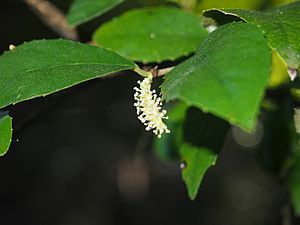Streblus brunonianus facts for kids
Quick facts for kids Streblus brunonianus |
|
|---|---|
 |
|
| Whalebone tree in a jungle understorey at the Allyn River, Barrington Tops, Australia | |
| Scientific classification | |
| Genus: |
Streblus
|
| Species: |
brunonianus
|
| Synonyms | |
|
|
Streblus brunonianus, known as the whalebone tree, is a small tree in the fig family. Commonly seen in a variety different types of rainforest, particularly by streams.
Streblus brunonianus occurs from near Milton (35° S) in the southern Illawarra district of New South Wales to Cape York Peninsula at the top of Australia. It also occurs in New Guinea and other Pacific Islands.
Other common names include the white handlewood, axe-handle wood, grey handlewood and prickly fig.
Description
A large shrub or small tree. However, rarely it can grow to a large tree, 30 metres tall and 40 cm in trunk diameter. The trunk is mostly cylindrical or flanged. The bark is brown, featuring lines of vertical pustules.
Leaves are thin with a long pointed tip. 5 to 8 cm long, alternate and simple. Usually finely toothed. The underside of the leaf is hairy, the top is glossy and mid green in colour. Leaf venation is more evident on the undersurface. Unlike in other species, the lateral veins do not terminate in leaf serrations.
Flowers appear from September to May. Male flowers on spikes, female flowers on small clusters or spikes. The fruit matures from January to May, being a yellow coloured berry, 4 to 6 mm long. Round pale coloured seeds 3 mm in diameter.
Germination from fresh seed occurs without difficulty within seven weeks. The fruit is eaten by birds including the brown cuckoo dove, green catbird, Lewin's honeyeater, rose crowned fruit dove and topknot pigeon.
(other publication details, included in citation)
See also
 In Spanish: Streblus brunonianus para niños
In Spanish: Streblus brunonianus para niños


